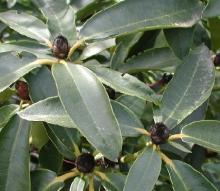Cause Seifertia azaleae (formerly Briosia azaleae) , a fungus that infects terminal flower buds through axils of the bud scales. Diseased buds may remain attached for 2 to 5 years. Insects and slashing rain spread spores to healthy buds. Plant types range in susceptibility with up to 90% of the buds infected on the cultivar Pink Pearl.
Symptoms Terminal flower buds turn black and bear many fungal fruiting bodies (synnemata). These synnemata are long, thin outgrowths capped by slimy balls that contain the conidia of the fungus. Dead flower buds appear like a fuzzy pincushion.
Cultural control
- Remove and destroy dead flower buds.
Chemical control Although copper has been suggested the disease is not known to be so bad as to need specific chemical applications for control.
Reference Glawe, D.A. and Hummel, R.L. 2006. New North American host records for Seifertia azaleae, cause of Rhododendron bud blight disease. Pacific Northwest Fungi 1(5):1-6.



